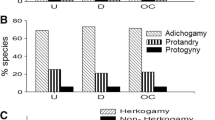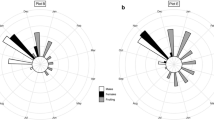Summary
In rain forest study plots, the sexes of Compsoneura sprucei (Myristicaceae) were radomly distributed and similar in vegetative dimensions. The sex ratio among adults was estimated as 1.25 male: female. The population showed two flowering episodes per year, of unequal intensity. Sexual dimorphisms in order of increasing difference included the frequency of flowering, the number of flowers per inflorescence and the number of inflorescences per tree. Most females matured only 0–10 seeds per tree per flowering episode. Tree size was a better indicator of fecundity in males than females. Reproduction in both sexes was dominated by a very few prolific trees.
Similar content being viewed by others
References
Augspurger CK (1980) Mass flowering of a tropical shrub (Hybanthus prunifolius): influence on pollinator attraction and movement. Evolution 34:475–488
Augspurger CK (1981) Reproductive synchrony of a tropical shrub: experimental studies on effects on pollinators and seed predators on Hybanthus prunifolius (Violaceae). Ecology 62:775–788
Baker HG (1959) Reproductive methods as factors in speciation of flowering plants. Cold Spring Harbor Symp Quant Biol 24:177–190
Baker HG (1967) Support for Baker's law — as a rule. Evolution 21:853–856
Bawa KS (1980) Evolution of dioecy in flowering plants. Ann Rev Ecol Syst 11:15–39
Bawa KS, Opler PA (1977) Spatial relationships between staminate and pistillate plants of dioecious tropical forest trees. Evolution 31:64–68
Bawa KS, Crisp JE (1980) Wind-pollination in the understorey of a rain forest in Costa Rica. J Ecol 68:871–876
Bierzychudek P (1981) Pollinator limitation of plant reproductive effort. Am Natur 117:838–840
Bourgeois WM, Cole DW, Riekerk H, Gessel P (1972) Geology and soils of comparative ecosystems study areas, Costa Rica. Inst For Prod Contrib 11. Univ Washington, Seattle
Bullock SH (1981) Fecundidad femenina en Jacaratia mexicana. In: VIII Congreso Mexicano de Botánica, Soc Bot Mex, abstract 279
Bullock SH, Bawa KS (1981) Sexual dimorphism and the annual flowering pattern in Jacaratia dolichaula (D. Smith) Woodson (Caricaceae) in a Costa Rican rain forest. Ecology 62:1494–1504
Bullock SH, Beach JH, Bawa KS (1982) Episodic flowering and sexual dimorphism in Guarea rhopalocarpa in a Costa Rican rain forest. Ecology: in press
Clark PJ, Evans FC (1954) Distance to nearest neighbor as a measure of spatial relationships in populations. Ecology 35:445–453
Conn JS, Wentworth TR, Blum U (1980) Patterns of dioecism in the flora of the Carolinas. Am Midl Natur 103:310–315
Frankie GW, Baker HG, Opler PA (1974) Comparative phenological studies of trees in tropical wet and dry forests in the lowlands of Costa Rica. J Ecol 62:881–919
Freeman DC, Klikoff LG, Harper KT (1976) Differential resource utilization by the sexes of dioecious plants. Science 193:597–599
Freeman DC, Harper KT, Ostler WK (1980) Ecology of plant dioecy in the intermountain region of western North America and California. Oecologia 44:410–417
Grant MC, Mitton JB (1980) Elevational gradients in adult sex ratios and sexual differentiation in vegetative growth rates of Populus tremuloides Michx. Evolution 33:914–918
Hartshorn GS (1978) Tree falls and tropical forest dynamics. In: PB Tomlinson, MH Zimmermann (eds) Tropical trees as living systems, Cambridge Univ Press, Cambridge, pp 615–638
Howe HF, DeSteven D (1979) Fruit production, migrant bird visitation of the tree Casearia nitida (Flacourtiaceae). Biotropica 7:278–283
Howe HF, VanderKerckhove GA (1980) Nutmeg dispersal by tropical birds. Science 210:925–927
Hubbell SP (1979) Tree dispersion, abundance and diversity in a tropical deciduous forest. Science 203:1299–1309
Janzen DH (1978) Seeding patterns of tropical trees. In: PB Tomlinson, MH Zimmermann (eds) Tropical trees as living systems. Cambridge Univ Press, Cambridge, pp 83–128
Lloyd DG, Webb CJ (1977) Secondary sex characters in plants. Bot Rev 43:177–216
Melampy MN, Howe HF (1977) Sex ratios in the tropical tree Triplaris americana (Polygonaceae). Evolution 31:867–872
Opler PA, Frankie GW, Baker HG (1980) Comparative phenological study of treelet and shrub species in tropical wet and dry forest in the lowlands of Costa Rica. J Ecol 68:167–188
Pielou EC (1961) Segregation and symmetry in two-species populations as studied by nearest-neighbor relationships. J Ecol 49:255–269
Piñero D, Sarukhán J (1982) Reproductive behavior and its individual variability in a tropical palm. J Ecol: in press
Richards P, Williamson GB (1975) Treefalls and patterns of understory species in a wet lowland tropical forest. Ecology 56:1226–1229
Skutch AF (1980) Arils as food for tropical American birds. Condor 82:31–42
Smith AC, Wodehouse RP (1937) The American species of Myristicaceae. Brittonia 2:393–510
Stiles FG (1978) Temporal organization of flowering among the hummingbird foodplants of a tropical wet forest. Biotropica 10:194–210
Vandermeer JH, Stout J, Miller G (1974) Growth rates of Welfia georgii, Socratea durissima, and Iriartea gigantea under various conditions in a natural rainforest in Costa Rica. Principes 18:148–154
Wallace CS, Rundel PW (1979) Sexual dimorphism and resource allocation in male and female shrubs of Simmondsia chinensis. Oecologia 44:34–39
Williams GC (1975) Sex and Evolution. Princeton Univ Press, Princeton
Author information
Authors and Affiliations
Rights and permissions
About this article
Cite this article
Bullock, S.H. Population structure and reproduction in the neotropical dioecious tree Compsoneura sprucei . Oecologia 55, 238–242 (1982). https://doi.org/10.1007/BF00384493
Received:
Issue Date:
DOI: https://doi.org/10.1007/BF00384493




